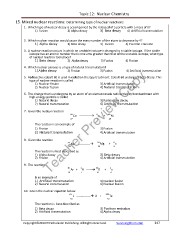Page 357 - Teacher Preview Copy
P. 357
.
Topic 12: Nuclear Chemistry
15. Mixed nuclear reactions: Determining type of nuclear reactions
1. Which type of nuclear decay is accompanied by the released of a particle with a mass of 0?
1) Fusion
3) Beta decay 4) Artificial transmutation
2) Alpha decay
2. Which nuclear reaction would cause the mass number of the atom to decrease by 4?
1) Alpha decay 2) Beta decay 3) Fusion 4) Positron emission
3. A nuclear reaction occurs in which an unstable isotope is changed to a stable isotope. If the stable
isotope has an atomic number that is one amu greater than that of the unstable isotope, what type
of nuclear reaction took place? 3) Fusion 4) Fission
1) Beta decay
2) Alpha decay
.
4. Which nuclear process is a type of natural transmutation? 4) Artificial transmutation
2) Fission
Teacher Preview Copy
3) Fusion
1) Alpha decay
5. Radioactive cobalt-60 is used in radiation therapy treatment. Cobalt-60 undergoes beta decay. This
type of nuclear reaction is called
1) Nuclear fission 3) Artificial transmutation
2) Nuclear fusion
4) Natural transmutation
6. The change that is undergone by an atom of an element made radioactive by bombardment with
high-energy particle is called
1) Natural decay 3) Radioactive decay
2) Natural transmutation 4) Artificial transmutation
7. Given the nuclear reaction
0
60
60 Co ------------ e + Ni
27
- 1 28
Teacher Preview Copy
The reaction is an example of
1) Fission 3) Fusion
4) Artificial transmutation
2) Natural transmutation
8. Given the reaction
24
0
24 Na ------------ Mg + e
11 12 -1
The reaction is best described as
1) Alpha decay 3) Beta decay
2) Fission
4) Artificial transmutation
9. The reaction
1
1
40 Ar + H ------ K + n
40
18 1 19 0
Is an example of
1) Artificial transmutation 3) Nuclear fusion
2) Natural transmutation 4) Nuclear fission
10. Given the nuclear equation below
121 I -------------- X + 121 Te
53 52
The reaction is best described as
1) Beta decay 3) Positron emission
2) Artificial transmutation 4) Alpha decay
Copyright©2010 E3 Scholastic Publishing. All Rights Reserved. SurvivingChem.com 347
Topic 12: Nuclear Chemistry
15. Mixed nuclear reactions: Determining type of nuclear reactions
1. Which type of nuclear decay is accompanied by the released of a particle with a mass of 0?
1) Fusion
3) Beta decay 4) Artificial transmutation
2) Alpha decay
2. Which nuclear reaction would cause the mass number of the atom to decrease by 4?
1) Alpha decay 2) Beta decay 3) Fusion 4) Positron emission
3. A nuclear reaction occurs in which an unstable isotope is changed to a stable isotope. If the stable
isotope has an atomic number that is one amu greater than that of the unstable isotope, what type
of nuclear reaction took place? 3) Fusion 4) Fission
1) Beta decay
2) Alpha decay
.
4. Which nuclear process is a type of natural transmutation? 4) Artificial transmutation
2) Fission
Teacher Preview Copy
3) Fusion
1) Alpha decay
5. Radioactive cobalt-60 is used in radiation therapy treatment. Cobalt-60 undergoes beta decay. This
type of nuclear reaction is called
1) Nuclear fission 3) Artificial transmutation
2) Nuclear fusion
4) Natural transmutation
6. The change that is undergone by an atom of an element made radioactive by bombardment with
high-energy particle is called
1) Natural decay 3) Radioactive decay
2) Natural transmutation 4) Artificial transmutation
7. Given the nuclear reaction
0
60
60 Co ------------ e + Ni
27
- 1 28
Teacher Preview Copy
The reaction is an example of
1) Fission 3) Fusion
4) Artificial transmutation
2) Natural transmutation
8. Given the reaction
24
0
24 Na ------------ Mg + e
11 12 -1
The reaction is best described as
1) Alpha decay 3) Beta decay
2) Fission
4) Artificial transmutation
9. The reaction
1
1
40 Ar + H ------ K + n
40
18 1 19 0
Is an example of
1) Artificial transmutation 3) Nuclear fusion
2) Natural transmutation 4) Nuclear fission
10. Given the nuclear equation below
121 I -------------- X + 121 Te
53 52
The reaction is best described as
1) Beta decay 3) Positron emission
2) Artificial transmutation 4) Alpha decay
Copyright©2010 E3 Scholastic Publishing. All Rights Reserved. SurvivingChem.com 347


